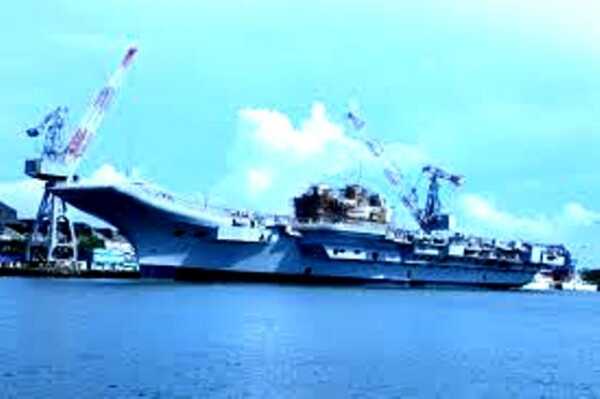 New Delhi : The country’s first indigenous aircraft carrier, INS ‘Vikrant’, to be delivered to the nation on the 75th anniversary of Independence, was handed over to the Indian Navy on Thursday.
New Delhi : The country’s first indigenous aircraft carrier, INS ‘Vikrant’, to be delivered to the nation on the 75th anniversary of Independence, was handed over to the Indian Navy on Thursday.
The indigenous aircraft carrier will soon be inducted into the Indian Navy fleet, which will boost India’s position in the Indian Ocean Region (IOR) and blue water navy. With the delivery of INS Vikrant, India joins a select group of countries that have the unique capability to indigenously design and build aircraft carriers. It will provide an anti-submarine warfare capability to the Indian Navy.
The construction of the Indigenous Aircraft Carrier (IAC) INS Vikrant was started on February 28, 2009 at the Cochin Shipyard in Kochi. Vikrant was launched on August 12, 2013, after construction was completed in two years. In December 2020, the aircraft carrier was completely successful in the basin trials conducted by CSL. The country’s first indigenous aircraft carrier, IAC Vikrant, weighing 40,000 tonnes, has successfully completed all four sea trials. The first test was completed on August 21, last year, the second on October 21, and the third on January 22. The last and fourth sea trials of IAC’s Vikrant started in May, which were successfully completed earlier this month.
The Indian Navy will become one of the top three navies in the world in the coming years after it joins the Indian biggies. This indigenous aircraft carrier is a shining example of Self-reliant India. ₹ 20,000 crore have been spent on its construction.
The project has been carried forward in three phases of contract between the Ministry of Defense and Cochin Shipyard Limited, which took place in May 2007, December 2014, and October 2019, respectively. The Naval Design Directorate has designed it using 3D virtual reality models and advanced engineering software. The Indian Navy created maritime history by taking delivery of the iconic Indigenous Aircraft Carrier (AC) Vikrant from its builder, Cochin Shipyard Limited (CSL), Kochi.
The ship named INS Vikrant played a role in the naval siege of erstwhile East Pakistan (Bangladesh) in the Indo-Pak war of 1971. Therefore, to keep the name of INS Vikrant alive, it was decided to indigenously build another warship with the same name. The construction of the Air Defense Ship (ADS) was to begin at the Cochin Shipyard in 1993, but the plans to build the ships were put on hold indefinitely after the 1991 economic crisis. In 1999, the then Defense Minister, George Fernandes, approved the construction of 71 ADS by reviving the project. After this, work on the design of the new Vikrant ship started and finally got formal government approval in January 2003. Meanwhile, in August 2006, Admiral Arun Prakash, the then Chief of Naval Staff, changed the ship’s designation from Air Defense Ship (ADS) to Indigenous Aircraft Carrier (IAC).
During the construction of this modern aircraft carrier, the design was changed and the weight was increased from 37 to 40,000 metric tonnes. Similarly, the length of the ship increased from 252 m (826.772 ft) to 262 m (859.58 ft). It is 60 metres (196.85 ft) wide. The ship is powered by four gas turbines with a total power of 88 MW and has a maximum speed of 28 knots.
It can carry about thirty aircraft, including indigenously built Advanced Light Helicopters (ALH) and Light Combat Aircraft (LCA), besides MiG-29K fighter jets, Kamov-31, and MH-60R multi-role helicopters. It has been fitted with a Kamov Ka-31 Airborne Early Warning, which will give this indigenous ship anti-submarine warfare capability to the Navy.

